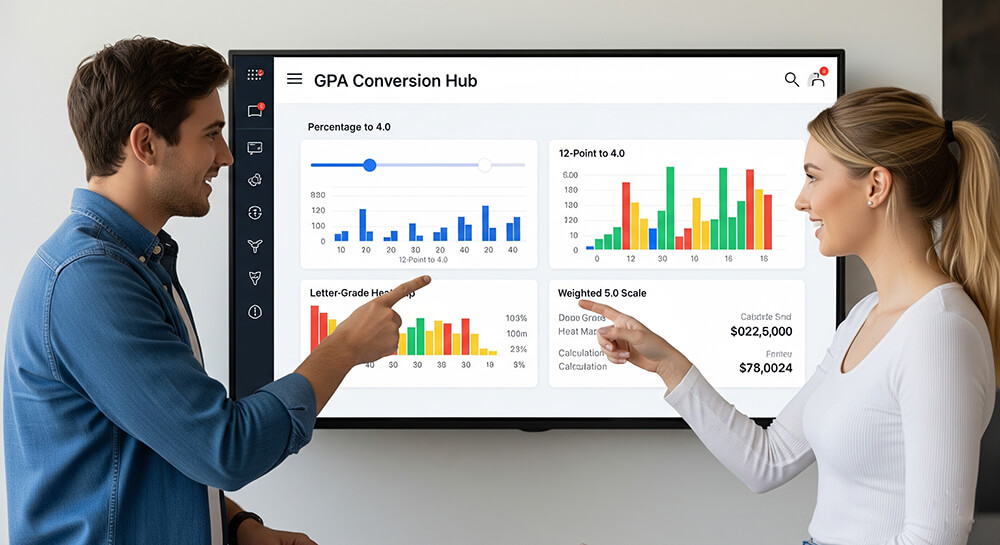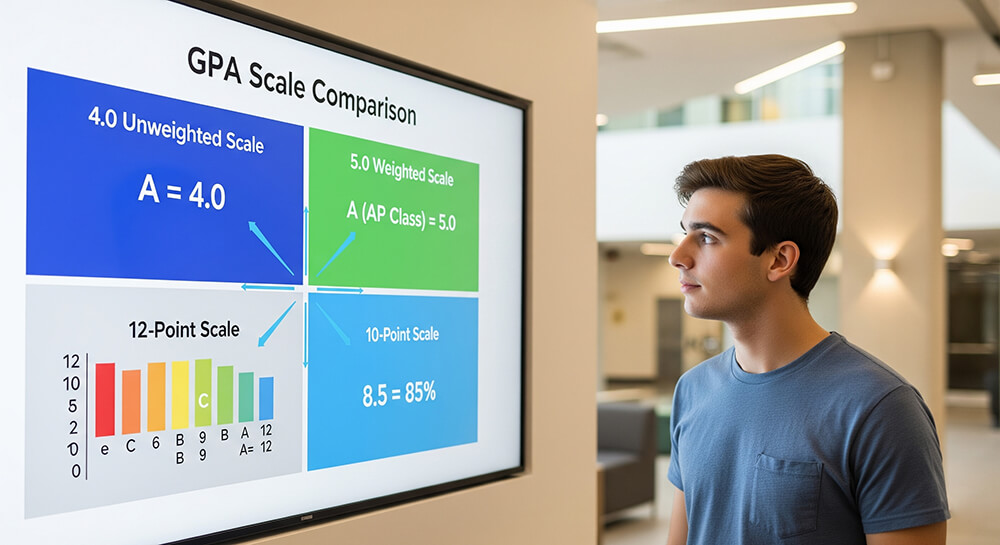From Ontario's 12-Point System to a U.S. 4.0 GPA: A Conversion Guide
Converting grades from the Ontario 12-point system to the 4.0 GPA scale used in the United States can feel complicated. Canadian universities, like McMaster, use a 12-point scale where a 12 is the top mark. The U.S. system uses a 4.0 scale. This guide explains how to make the conversion, the challenges you might face, and how to present your grades accurately.
| Key Takeaway | Description |
|---|---|
| Direct Conversion Isn't Always Accurate | Simply converting the average of your 12-point grades doesn't work. Each course grade must be converted to the 4.0 scale individually before calculating the final GPA. |
| Official Tables are Best | Use official conversion tables, like the one from the Ontario Medical School Application Service (OMSAS), for the most accurate results. |
| Grade Deflation is Real | Universities like the University of Toronto are known for grade deflation, where it is harder to get high marks. This means your GPA might seem lower than that of students from other schools. |
| U.S. Schools Have Experience | Many U.S. admissions offices are familiar with Canadian grading systems and consider these differences when they review applications. |
Understanding the Ontario 12-Point Scale
The Ontario 12-point scale is a grading system used by several universities, most notably McMaster University. On this scale, an A+ (90-100%) equals a 12, an A (85-89%) is an 11, and so on. It is important to understand the different types of GPA scales to see how they measure academic achievement. A detailed 12-point to 4-point scale chart can help you see the direct equivalents for each grade.
How to Convert Your 12-Point GPA to a 4.0 Scale
The correct way to convert your GPA is to translate each course grade from the 12-point scale to the 4.0 scale first. After you convert each grade, you can then calculate the average. You cannot just take your overall 12-point average and convert it directly. For a clear process, follow a guide on how to calculate GPA. Using a standard GPA formula guide ensures you account for course credits properly.
Common Conversion Challenges: Grade Deflation
A significant challenge for Ontario students is grade deflation. This is especially true at schools like the University of Toronto, where class averages are often kept intentionally lower. This practice can put students at a disadvantage when their GPAs are compared to those from U.S. schools where grade inflation is more common. Understanding GPA inflation vs. deflation explained provides context for this issue. To ensure your conversion is correct, it is wise to learn about common GPA calculation errors to avoid.
Using a College GPA Calculator for Accuracy
To simplify the conversion process, you can use an online tool. A college GPA calculator helps you input your grades and credits to get an accurate 4.0 GPA. If you are still in high school, a high school GPA calculator can also be useful for planning. These tools are designed to handle different grading systems and provide a reliable result.
Handling Special Grades and Scenarios
Your transcript may have more than just standard letter grades. It is important to know how pass/fail grades impact your GPA. If you have credits from another institution, a transfer credits GPA integrator can help you combine them correctly. For courses that are not finished, a guide on GPA planning for incomplete grades can show you how to manage them. An incomplete grades scenario planner can also help you see potential outcomes.
Weighted vs. Unweighted GPA in Canada
In the U.S., GPAs are often "weighted" to give more value to advanced courses like AP or Honors. This is less common in Canada. Understanding the difference between a weighted vs. unweighted GPA is key. If you have taken advanced classes, a GPA weighting guide for Honors & AP can help you explain their rigor on applications. You can use a weighted vs unweighted gpa calculator to see the difference.
Tracking Your GPA Over Time
Monitoring your academic progress is essential. A cumulative GPA calculator allows you to track your overall GPA throughout your studies. You can also use a semester GPA calculator to check your performance each term. For a visual representation of your progress, a GPA trend graph generator can be very helpful. This can also be useful when using a multi-semester gpa bulk import tool.
Global GPA Scale Comparisons
Grading systems differ worldwide. It can be useful to see a GPA scale comparison to understand how various systems measure up. For example, learning about the UK class system grades to 4.0 GPA conversion or the Indian 10-point GPA to 4.0 scale conversion shows the global diversity in academic assessment. This knowledge helps you understand the bigger picture of GPA conversion charts & tools.
Tips for Improving Your Grades
If you are looking to boost your GPA, focusing on effective study habits is the best place to start. Simple changes can lead to big improvements. Explore some study tips for better grades to learn new strategies. Better time management and active learning techniques can help you raise your marks in any grading system.
Frequently Asked Questions (FAQ)
Q1: What is the simplest way to convert my Ontario 12-point GPA? The best method is to convert each course grade individually to the 4.0 scale using an official conversion chart, like the OMSAS table, and then find the average. Do not convert your final 12-point average directly.
Q2: Do U.S. colleges understand grade deflation at Canadian schools? Yes, many admissions officers at U.S. universities are familiar with the academic rigor and grade deflation at certain Canadian institutions like the University of Toronto and McGill. They often evaluate your transcript in the context of your school.
Q3: Should I use a professional service like WES? For official applications, especially for graduate programs, using a service like World Education Services (WES) is often required. They provide a credential evaluation that standardizes your grades for U.S. institutions.
Q4: How are pass/fail grades handled in GPA conversion? Generally, pass/fail courses are not included in the GPA calculation. However, they do count toward your total credits. Always check the specific policy of the institution you are applying to.









